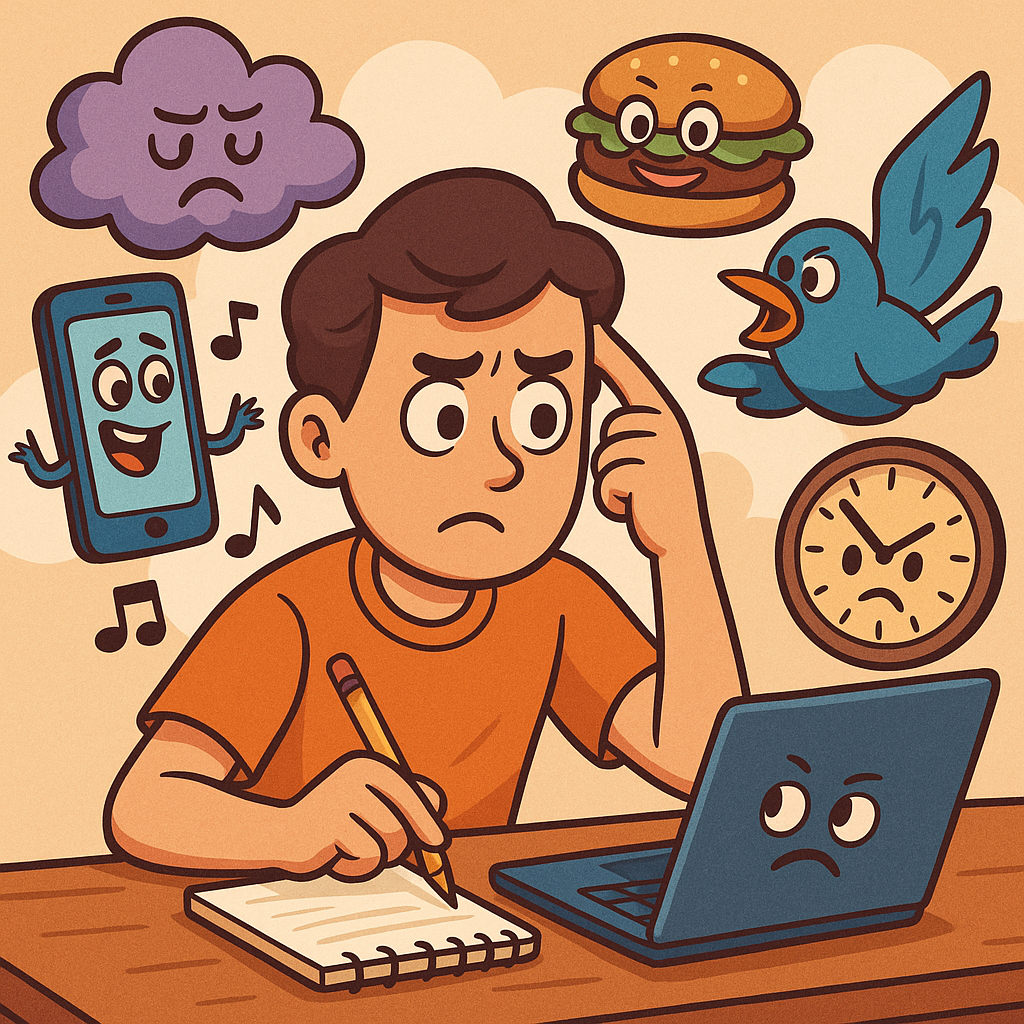We all get distracted—but those interruptions are messaging tools from our brain, habits, and environment. Understanding what distractions are actually telling you can help transform scattered attention into insight, better habits, and improved focus.

Why Our Brains Send Distraction Signals
1. Your brain is learning selective attention
Recent EEG research shows the brain adapts: it learns to ignore recurring distractions—like flashing banners or billboard ads—by tuning them out at early visual processing stages.
Distraction insight: If you’re not blocked out by a recurring distraction, something about it is still novel or emotionally resonant.
2. Digital interruptions reflect internal needs
Studies on “social media distraction” identify two core drives for what distractions are actually telling you: staying connected (social) and escaping a less pleasant task (avoidance).
Distraction insight: A ping at the end of a boring task often signals boredom or inadequate motivation, not just tech overload.
3. Attention fatigue is real and physical
The concept of directed attention fatigue explains that prolonged focus drains your capacity to maintain attention. Natural stimuli and breaks are needed to replenish focus.
Distraction insight: If your mind drifts during deep work, it may not be laziness—it could be cognitive exhaustion signaling a need for rest or replenishment.
The Current Context: Why Distractions Matter Now
Shrinking attention spans
A recent global study reported alarming declines in attention due to constant digital engagement—with multitasking myths debunked and solutions like active breaks proving effective.
Key note: Frequent distractions aren’t just random—they’re part of a larger attention challenge in the digital age.
Social media’s giant productivity cost
- 77% of employees admit to using social media at work.
- Students checking social media during study scored up to 20% lower on exams.
Distraction insight: Digital environments are full of cues that hijack attention. But each cue is a signal—either your task lacks engagement, or your environment is misaligned with your goals.
What Each Type of Distraction Could Be Telling You
1. Notifications & Pings
What they’re saying: You’ve trained your brain to respond to novelty.
Frequent alerts reinforce a cycle of checking for dopamine-style hits.
In response: Turn off non-essential notifications—keep only the ones tied to your highest priorities.
2. Mind-wandering and daydreams
What they’re saying: Your brain is rebooting or craving stimulation.
Mind-wandering can be creativity surging or your focus system needing a break.
In response: Schedule brief mindful pauses or enrich tasks with variation to maintain interest.
3. Anxiety-driven checking (FoMO)
What it’s saying: You’re seeking social connection or reassurance.
Studies link internal and external cues to FoMO-driven distraction.
In response: Build designated social-check windows instead of scanning continuously.
4. Task avoidance & boredom
What it’s saying: The task is either unstimulating or too hard.
Digital distractions offer instant relief from discomfort.
In response: Break tasks into smaller, rewarding chunks to improve your threshold for focus.
5. Physical fatigue or environmental tension
What it’s saying: Your directed attention muscles are depleted.
In response: Take short breaks in nature, move around, or use soft fascination (e.g., looking at plants or a view).
A Practical Guide: Turning Distraction Signals into Action
- Track distractions for 2 days
- Use a simple worksheet: record what cutoff your task, when, and how long you stayed off task.
- Pattern recognition helps identify root causes (e.g., boredom, anxiety, digital alerts).
- Categorize them → apply the insights above.
- Is it FoMO? Turn off alerts.
- Is it fatigue? Take a nature stroll.
- Build micro-routines to support mental stability
- Respite breaks (10 minutes off-screen) to refresh attention.
- Single-task blocks with 25–50 minute focus + 5–10 min break cycles.
- Notification batching—check messages at set intervals.
- Design your environment deliberately
- Mute or disable aspects of your digital UI.
- Keep a water glass or mind-tracking journal visible for quick context checks.
- Monitor your progress weekly
- Did repeated distractions decline?
- Are focus blocks lasting longer?
When Distractions Become Insight: A Mini-Case Study
Meet Aisha, a product designer working from home. She noticed every afternoon she’d drift into email-checking and doom-scroll Instagram. Instead of dismissing this as laziness, she tracked her behavior:
- Signal 1: It always happened post-lunch → fatigue.
- Signal 2: It coincided with stalled design ideas → frustration, task block.
- Signal 3: Notifications chiming in triggered the spiral.
Her pivots:
- Replaced 2 pm Instagram scans with a 10‑minute walk.
- Used design “warm-up” prompts to jumpstart blocked ideas.
- Silenced non-essential alerts during work blocks.
Within a week, her afternoon drift nearly vanished—and she generated more creative work. Her distractions had spoken, and she listened.
Broader Implications: Culture, Design & Attention Ecology
- Gen Z is pushing back: A recent survey found 86% are reducing social media use, and 26% have embraced full digital detoxes.
- Tech designers are responding: The rise of “calm technology” seeks to reduce intrusive alerts and support respectful digital rhythms.
- Psychologists emphasize the contextual view: Distraction is not disorder—it’s data about the fit between person, task, and environment.
Final Word: Let Your Distractions Inform You
If you’ve ever told yourself “I just can’t focus today,” step back. What are your distractions trying to tell you? Whether it’s an alert tugging for attention or mental fog impairing work, each is a clue. The frontier of improving focus in 2025 isn’t about ruthlessly fighting distractions: it’s about decoding their signals and responding intelligently.
When you listen—when you ask why not why not—distraction becomes insight. And insight is where real growth happens.
References
Eve Arnold, “Distraction Is Just a Manipulation of Human Psychology. You Can Beat It,” Medium, 2021. Available: https://eve-arnold.medium.com
Rachel and Stephen Kaplan, “Attention Restoration Theory,” Wikipedia, 2024. Available: https://en.wikipedia.org/wiki/Attention_restoration_theory
María Ángeles Pérez-Juárez, David González-Ortega & Javier M. Aguiar-Pérez, “Digital Distractions from the Point of View of Higher Education Students,” arXiv, 2024. Available: https://arxiv.org






